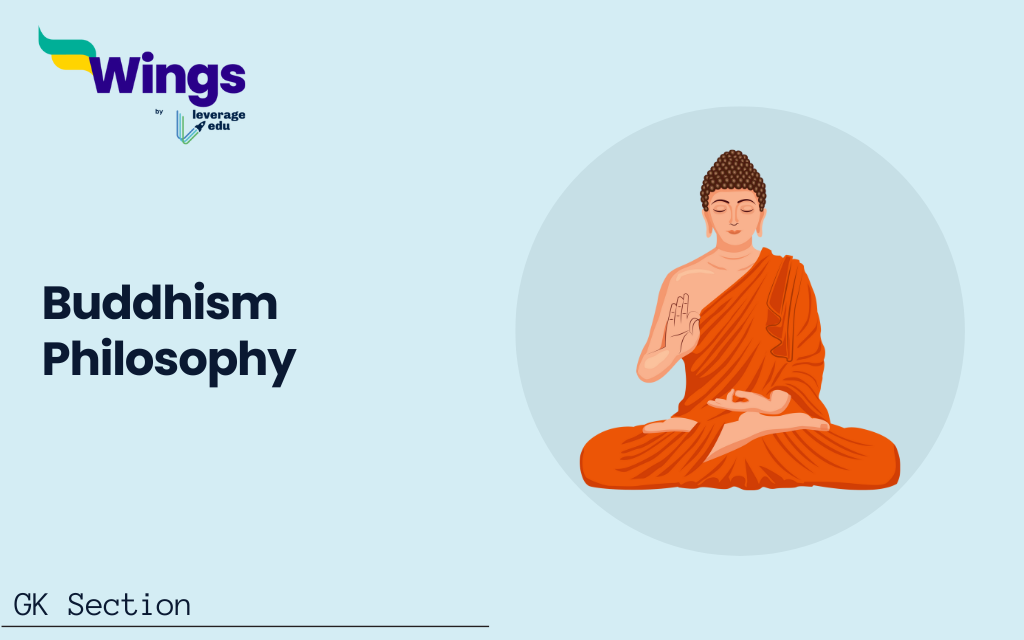Buddhism is regarded as a fresh representation of the wonderful truth in India. Lord Buddha’s enlightenment and subsequent teachings over nearly four decades were consistent with India’s legacy of intellectual freedom and spiritual variety. Buddhism’s philosophy and concepts are vital for aspirants to understand. Here we will go over the key concepts and philosophy of Buddhism, which will be useful for UPSC IAS Exam preparation.
Contents
Buddhism Philosophy and Concepts
Important concepts related to Buddhism are mentioned below:
- To avoid extremes in life, such as worldly pleasure addiction or strict asceticism and self-mortification.
- Buddhism is unconcerned about metaphysical conflicts.
- Buddha emphasised the necessity of moral progress, which existed independently of any universe creator.
- Buddhists believe that life is transient. Buddha appears to have acknowledged the idea of rebirth.
- The four primary Noble Truths describe the essential tenets of Buddhism. They are as follows:
- Dukkha – The reality about suffering.
- Samudaya- The truth about the source of suffering.
- Nirodha- The truth about the cessation of suffering.
- Marga- The truth about the route to the end of suffering.
- To put it another way, life is filled with sorrow (dukkha). The seeds of grief can be found in all aspects of life. Desire is the source of sadness. This traps a person in samsara, an endless cycle of rebirth, dukkha, and death.
- One can be free and at peace if they let go of their desires and demands.
- The ‘Noble Eightfold Path’ or ‘Ashtanga Marga’ can help the person achieve this.
Also read: Buddhist Art, Architecture and Literature
Noble Eightfold Path
The Noble Eightfold Path, also known as Ashtanga Marga, is an early exposition of Buddhist practices that lead to nirvana, or liberation from samsara, the terrible cycle of reincarnation.
- Kind, truthful, and correct language.
- Honest, peaceful, and appropriate actions.
- To find a suitable livelihood that does not harm others.
- Making the right effort and gaining self-control.
- Right mindfulness.
- Proper meditation and focus on the meaning of life.
- The appropriate thoughts reveal a man’s sincerity and intelligence.
- Avoid superstitions and build a proper knowledge.
- According to Buddha, Madhyam Marg, also known as the Middle Path or Middle Way, describes the quality of the Noble Eightfold Path that leads to Nirvana.
- Buddhism rejects the Vedas’ authenticity. In contrast to Jainism, it also rejects the concept of a soul (atman).
- When Buddha attained Mahaparinirvana in Kushinagar in 483 BC, there was a need to systematise his teachings, therefore four Buddhist Councils were formed over the next 500 years.
- As a result, three major pitakas were written: Vinaya, Sutta, and Abhidhamma, which were later combined to form the Tripitaka. Each of these papers was written in Pali.
Four Schools of Buddhism
Buddhism is an Asian religion and philosophy divided into four schools: Theravada, Mahayana, Tantric, and Zen. Each school has its own philosophy and teachings, although they all share core principles. All Buddhist education system share the same essential principles, which include the Four Noble Truths, the Noble Eightfold Path, and the Three Universal Laws.
Buddhism is a religion and philosophical system that emerged in India thousands of years ago. Today, it is the world’s fourth-largest religion, with over 500 million adherents. The Buddha taught that human suffering is caused by our desire and ignorance. Philosophical and meditative practices can help you find peace and pleasure.
We regard Buddhism as a single, homogeneous religion. However, it is a collection of distinct schools, each with its own set of beliefs and practices.
Also Read: Bharatanatyam
Hinayana Buddhism
- Hinayana Buddhists consider Gautama Buddha as a normal human being who gained Nirvana.
- It denotes the smaller vehicle.
- Around 250 BC, Hinayana Buddhism began to thrive.
Mahayana Buddhism
- It refers to the greater vehicle.
- The Mahayana Buddhist religion is thought to have been formed in the first century AD by Emperor Kanishka of the Kushana Empire.
- The school holds a more liberal view of Buddha’s celestial essence and the Bodhisattvas who embody it.
Theravada Buddhism
- It refers to the elder monastic school whose doctrinal base is the Pali Canon, which contains all of Buddha’s teachings.
- Pali is Theravada Buddhism’s sacred language.
- Theravada is considered to be a continuation of the Hinayana school.
Vajrayana Buddhism
- It is also referred to as Tantric Buddhism.
- Scholars believe that the Vajrayana school developed from royal palaces that funded both Buddhism and Shaivism, meaning that it was inspired by Hinduism.
Later times saw the emergence of new schools such as Zen Buddhism, Navayana Buddhism, and others throughout the world.
Recent Posts
| Indian Bronze Sculpture | Thangka Paintings |
| History of Zoroastrianism | Sufism in India |
| List Of Foreign Travellers | List of Common Cricket Terms |
FAQs
Vipassana is the oldest Buddhist meditation technique for enhancing consciousness. The approach is based on a discourse attributed to the Buddha, the Satipatthana Sutta [Foundations of Mindfulness].
Buddhism’s teachings revolve around the four noble truths, which are:
Dukha (Truth of Suffering)
Samudaya (The truth about the cause of sorrow)
Nirodha (The truth about the end of suffering)
Ashtangika-Marga (The Truth of the Path Leading to the End of Suffering)
The Tripitaka is a collection of sacred writings that includes Buddhist teachings, the Buddha’s words, and the foundation for monks’ teachings.
This was all about the “Buddhism Philosophy”. For more such informative blogs, check out our UPSC Exams Section and Study Material Section, or you can learn more about us by visiting our Indian exams page.
 One app for all your study abroad needs
One app for all your study abroad needs














